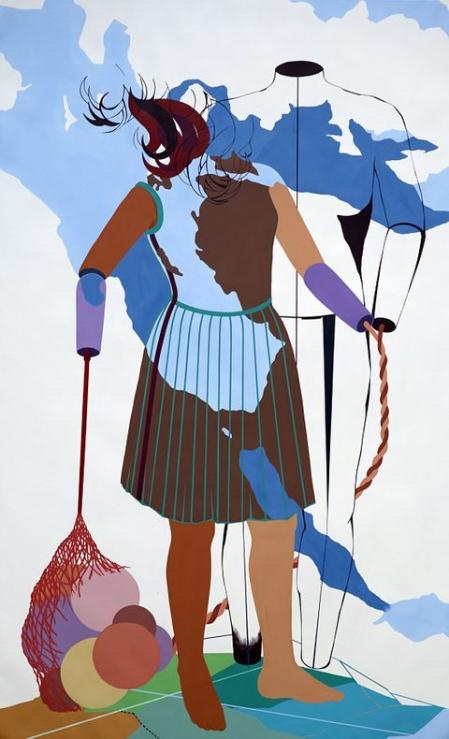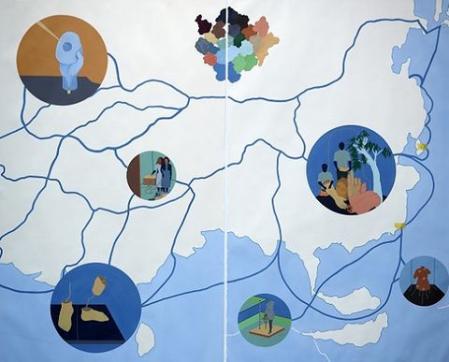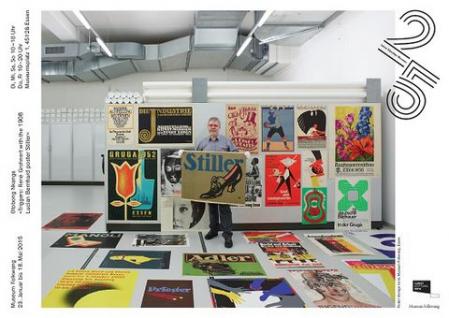Otobong Nkanga – Tracing Confessions
By Marcel Schumacher
A bowl rests on the flat of a hand, a hand of stone. In the course of her research in Museum Folkwang’s collections, artist Otobong Nkanga selected an object that brings together many stories and questions. This is no article of everyday use; this image of a human hand itself holds an object, a bowl or disc. What statement is this hand’s gesture supposed to convey: showing, holding, offering? The hand seems to have been broken off a statue and bears burn marks at the end of the arm. The artist has chosen an enigmatic, ambiguous object. She then created drawings, photographs, objects and exhibition furniture for her installation in Museum Folkwang that tell true and conceivably true stories relating to the hand.
Otobong Nkanga was invited by Kunststiftung NRW as part of the 25/25/25 Project to create a portrait of Museum Folkwang and present this in poster form. On the occasion of its 25th anniversary, Kunststiftung NRW has gifted 25 museums in NRW one such portrait each. The Nigerian artist, who is active on the international scene, developed a project for Weltkulturen Museum in Frankfurt on the basis of intensive research in the storerooms of the Ethnographical Museum there. Here in Essen she likewise found objects of a “world art” collection largely assembled around 1900 by the museum’s founder Karl Ernst Osthaus. However, she felt the collection was too varied and the museum’s other collections too rich and so chose a different way of approaching the task at hand.
The artist invited members of the museum staff to have an object of their choice photographed – in the hidden places in the museum, in the storerooms. In this way, she broached a dialogue with the curators and restorers on their specialist criteria and personal motives. René Grohnert, Director of Deutsches Plakat Museum at Museum Folkwang, for example, chose one of the most influential posters in German advertising history: a billboard poster for Schuhhaus Stiller. The posters in the background of the photograph reference past events in Essen such as a horticultural show or a concert at Gruga Hall. In this way, Nkanga visualizes the place where the respective object is to be found. Nkanga took this image of the posters as representative of the museum qua institution and used it as a poster theme, symbolising the ensemble of object, science, store, curator and beholder. As part of the 25/25/25 Project she will have the poster bill-boarded around the city of Essen and in this way familiarizes people in their everyday lives with the museum as an institution.
The museum director, curators, restorers and assistants chose objects not only with a view to the institutional context: Tobia Bezzola opted for a photograph by Robert Frank, whose oeuvre he will soon be exhibiting, Collection Manager Mario von Lüttichau chose a Baule statuette from Africa, because it is of such outstanding importance for the world art collection. Restorer Silke Zeich went for a Japanese basket owing to its beauty and perfect craftsmanship. Florian Ebner, Head of the Photographic Collection, took a humorous portrait photo by Eugene Richards. In the course of discussions with Nkanga, I myself selected an everyday item, an old basin for holy water, with a patina of its own. Why is such an object to be found in Museum Folkwang? In its early days, the museum was gifted a collection of applied art that was also meant to serve as a samples collection. There is a hand-written note jotted on an old index card alluding to an aesthetic paradigm of Modernism: Artistic value stems only from an object’s pure form. As background for the image, Nkanga then took artworks that reference the now extinct Essen steel industry: blast furnaces and a photo by Candia Höfer of a magnificent hall in the Krupp family villa. Relying on her interviews and the photographs Otobong Nkanga has managed to create a diverse portrait of the institution which will be published in the form of a postcard book.
Nkanga encountered the marble hand during her research and starting from it developed a multifaceted installation for the museum. The stone fragment probably originated in Gandhara in what is today Afghanistan. For many years it had been read as the hand of a Greek discus thrower – until being identified as the fragment of a Buddha. In the 1920s, the discovery of Buddhist statues in the Classical Greek style caused a real stir in Europe and was interpreted as the melding of Europe and Asia, of Western realism and Indian spiritualism. This hand’s shape derives from the dynamic realism of Western, Hellenist art that was introduced to the region by the entourage of Macedonian conqueror Alexander the Great. Its function and spiritual thrust derive, by contrast, from the meditative silence of Eastern Buddhism. When this religion first spread in Gandhara during the 1st century AD it was almost bereft of images. The tradition of Greek realism emphatically influenced the images of Buddhist art and spread further eastward along the Silk Road trading route; one could speak here of an early case of globalization.
Only stone fragments have survived of this cultural synthesis. First the Huns destroyed the cultic sites in the 5th century. Later, many of the images fell victim to the prohibition on human representations in the Koran and were destroyed when the one faith ousted the other. These fragments have always been cherished by European scholars of Antiquity and collectors, firing the imagination and more affordable in such a form. In retrospect, it is hard to say whether a particular fragment was actually found or had been broken off a statue, perhaps one carved into the rock of a cliff. In the 1920s, Museum Folkwang exhibited countless Buddhist images; the sculptural pieces from Gandhara were a major complement to the show. And they fascinated representatives of the new aesthetics of the day not just by virtue of their simplicity; Buddhist philosophy also appealed to many modern artists, one needs think only of Johannes Itten or the author Hermann Hesse. This history of the hand fell into oblivion after World War II, when a bomb left it under a massive pile of rubble. After it re-emerged as one fragment among many, no one knew exactly what it was and it was therefore catalogued as being the hand of a Greek discus thrower. For Nkanga, this interpretation also forms the basis for the narrative of European art.
In her large-format drawings, Otobong Nkanga reads the fragment as a metaphor for the transience of our faith in the magic of objects. The European view is also not entirely free of a faith in magic, the magic of art. She had a motto printed on coloured strips from which can cut themselves a piece, thus taking part of the artwork home with them: “Ist Got mit uns we kan weder uns” – if God is with us, who can be against us. The motto stems from the bronze vessel I chose for the photograph. As a basin for holy water it represents the belief in the magic of matter, as contact with the blessed water is supposed to transfer the blessing onto you. It is a strange coincidence that this basin was probably acquired in the midst of World War II – when the Nazis robbed Museum Folkwang of the modern art they so ostracized.
In her oeuvre, Nkanga constantly references the act of touching objects with one’s hands. In some drawings, we see people whose hands have been cut off, robbing them of their sense of touch or they are connected to objects not by their hands but by sticks. She believes that the hand and the sense of touch are keys to the emotional bonding of subject and object. Otobong Nkanga’s art allows viewers to expand their position as beholders and view the museum’s objects from an array of different positions.
Share on



